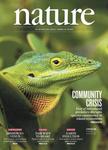作者:Dreiling, Reagan J.; Huynh, Kathleen; Fors, Brett P.
作者单位:Cornell University
摘要:Crosslinked thermosets are highly durable materials, but overcoming their petrochemical origins and inability to be recycled poses a grand challenge(1, 2-3). Many strategies to access crosslinked polymers that are bioderived or degradable-by-design have been proposed, but they require several resource-intensive synthesis and purification steps and are not yet feasible alternatives to conventional consumer materials(4, 5, 6, 7-8). Here we present a modular, one-pot synthesis of degradable therm...
作者:Sayer, Catherine A.; Fernando, Eresha; Jimenez, Randall R.; Macfarlane, Nicholas B. W.; Rapacciuolo, Giovanni; Boehm, Monika; Brooks, Thomas M.; Contreras-MacBeath, Topiltzin; Cox, Neil A.; Harrison, Ian; Hoffmann, Michael; Jenkins, Richard; Smith, Kevin G.; Vie, Jean-Christophe; Abbott, John C.; Allen, David J.; Allen, Gerald R.; Barrios, Violeta; Boudot, Jean-Pierre; Carrizo, Savrina F.; Charvet, Patricia; Clausnitzer, Viola; Congiu, Leonardo; Crandall, Keith A.; Cumberlidge, Neil; Cuttelod, Annabelle; Dalton, James; Daniels, Adam G.; De Grave, Sammy; De Knijf, Geert; Dijkstra, Klaas-Douwe B.; Dow, Rory A.; Freyhof, Joerg; Garcia, Nieves; Gessner, Joern; Getahun, Abebe; Gibson, Claudine; Gollock, Matthew J.; Grant, Michael I.; Groom, Alice E. R.; Hammer, Michael P.; Hammerson, Geoffrey A.; Hilton-Taylor, Craig; Hodgkinson, Laurel; Holland, Robert A.; Jabado, Rima W.; Juffe Bignoli, Diego; Kalkman, Vincent J.; Karimov, Bakhtiyor K.; Kipping, Jens; Kottelat, Maurice; Laleye, Philippe A.; Larson, Helen K.; Lintermans, Mark; Lozano, Federico; Ludwig, Arne; Lyons, Timothy J.; Maiz-Tome, Laura; Molur, Sanjay; Ng, Heok Hee; Numa, Catherine; Palmer-Newton, Amy F.; Pike, Charlotte; Pippard, Helen E.; Polaz, Carla N. M.; Pollock, Caroline M.; Raghavan, Rajeev; Rand, Peter S.; Ravelomanana, Tsilavina; Reis, Roberto E.; Rigby, Cassandra L.; Scott, Janet A.; Skelton, Paul H.; Sloat, Matthew R.; Snoeks, Jos; Stiassny, Melanie L. J.; Tan, Heok Hui; Taniguchi, Yoshinori; Thorstad, Eva B.; Tognelli, Marcelo F.; Torres, Armi G.; Torres, Yan; Tweddle, Denis; Watanabe, Katsutoshi; Westrip, James R. S.; Wright, Emma G. E.; Zhang, E.; Darwall, William R. T.
作者单位:Universidad Autonoma del Estado de Morelos; Conservation International; Northern Arizona University; Zoological Society of London; University of Alabama System; University of Alabama Tuscaloosa; Western Australian Museum; Centre National de la Recherche Scientifique (CNRS); Universite de Lorraine; Universidade Federal do Ceara; University of Padua; George Washington University; Northern Michigan University; University of Oxford; Research Institute for Nature & Forest; Naturalis Biodiversity Center; University of Malaysia Sarawak; Leibniz Institut fur Evolutions und Biodiversitatsforschung; Leibniz Association; Leibniz Institut fur Gewasserokologie und Binnenfischerei (IGB); Addis Ababa University; James Cook University; James Cook University; Universitas Hasanuddin; Royal Society for Protection of Birds; University of Southampton; University of Kent; Tashkent Institute of Irrigation & Agricultural Mechanization Engineers; University of Abomey Calavi; University of Canberra; Leibniz Institut fur Zoo und Wildtierforschung; Humboldt University of Berlin; National University of Singapore; Kerala University of Fisheries & Ocean Studies; University Antananarivo; Pontificia Universidade Catolica Do Rio Grande Do Sul; National Research Foundation - South Africa; South African Institute for Aquatic Biodiversity; Royal Museum for Central Africa; KU Leuven; American Museum of Natural History (AMNH); Meijo University; Norwegian Institute Nature Research; Mindanao State University System; Mindanao State University-IIT; Kyoto University; Chinese Academy of Sciences; Institute of Hydrobiology, CAS
摘要:Freshwater ecosystems are highly biodiverse(1) and important for livelihoods and economic development(2), but are under substantial stress(3). To date, comprehensive global assessments of extinction risk have not included any speciose groups primarily living in freshwaters. Consequently, data from predominantly terrestrial tetrapods(4,5) are used to guide environmental policy(6) and conservation prioritization(7), whereas recent proposals for target setting in freshwaters use abiotic factors(8...
